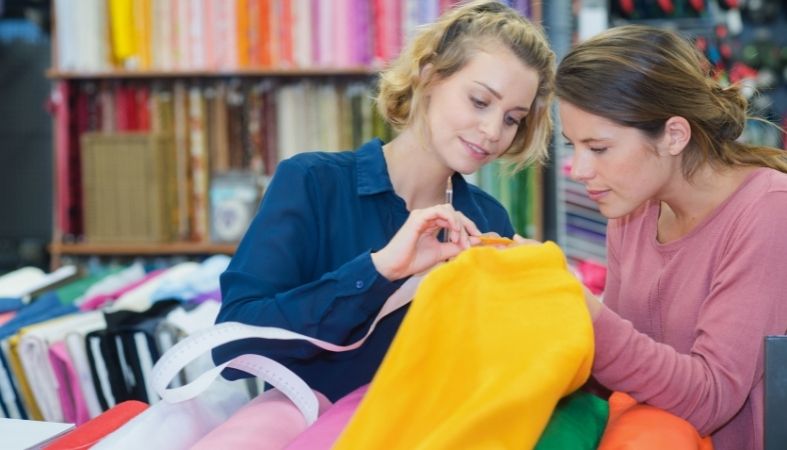The Definitive Guide to All 4 Way Stretch Fabrics
The Definitive Guide to All 4 Way Stretch Fabrics
Blog Article
Indicators on All 4 Way Stretch Fabrics You Should Know
Table of ContentsUnknown Facts About All 4 Way Stretch FabricsThe smart Trick of All 4 Way Stretch Fabrics That Nobody is DiscussingEverything about All 4 Way Stretch FabricsGetting My All 4 Way Stretch Fabrics To WorkGetting The All 4 Way Stretch Fabrics To Work
The material weight is reliant on numerous elements like the weave, fiber type, etc and is generally denoted by GSM. GSM can vary from 60 -700; 700 being the GSM of extremely high-quality woolen material.One thing you have to keep in mind is that higher fabric weight does not represent higher material quality. You can not choose high material weight fabric jeans for a lightweight drifting serape.
In a nutshell, the most crucial standards to look for in the fabric you get are as follows. The number of threads per inch of textile (yarns-per-inch).
In high-grade fabric, this balance (either in numbers or in size) will constantly be preserved. Procedures utilized on textile to enhance appearance and performance.
All 4 Way Stretch Fabrics for Dummies
A two-ply yarn transcends to a single-ply yarn.

If you are getting ready to begin a new sewing job, choosing a material will be one of the most vital action once you determine what you wish to make. After you've gone to all the problem and cost of buying the stitching equipment you enjoy, a pattern you enjoy, and a material you love, you desire the finished item to be a success, right? One means to accomplish that is to begin by seeing to it your fabric is genuinely ideal for the job.
How do you recognize which textile will provide you the best result? Selecting a fabric just since you enjoy the print or layout on it isn't always the finest technique.
In order to avoid doing a whole project for basically nothing, we've compiled some ideas to aid you make a decision which fabric is ideal for your project. Let's say you currently have a project in mind; exactly how do you find the best fabric for it?
3 Easy Facts About All 4 Way Stretch Fabrics Described
Think of the characteristics you want the finished product to have. Do you want a strong color or a print? If you are making a non-wearable thing such as a cushion cover or pot holder, use a durable material such as canvas.
There is a lot info around regarding materials, their attributes, and their uses, it can reach be overwhelming! Don't attempt to take it in all at once; simply begin with the project at hand. Find out all you can regarding the fabric you use for this one job.
Consist of little swatches for reference. You will certainly have your very own little library of information to surf when you start each new project.
If you're beginning with a pattern that you understand you desire to make, a lot of the time the pattern will certainly tell you which sort of visit this site material will certainly function best for that patternor a minimum of provide you guidelines. Remember that the guidelines are there for a factor; focus on them! You can make your very own decision and do your very own point, yet you may wind up needing to remodel it if it does not go so well.
All 4 Way Stretch Fabrics Fundamentals Explained
If you're a sewing novice, begin with cotton, such as you would find in the quilting area of a textile shop. Cotton is by much the most versatile and simplest textile to deal with, and nearly anything can be made with cotton. Be certain to clean it initially, considering that it does shrink.
Choose a thing of clothing to make, or a craft projectjust avoid points that need to be stretchy (knits) or upholstery-type jobs (heavy, sturdy fabrics). Besides woven cotton, materials that are simple to manage are flannel, non-flimsy woven silks, and wool or woollen blends. Avoid anything with a snooze, such as velour or phony fur, and stay clear of unsafe or large textiles.
You will boast of the completed project instead of irritated with time and materials lost. The Influenced Sewist uses stitching materials, classes, machines, and repair work. We can assist you find out brand-new methods or inspire you to get started, leading you via any kind of job you want to finish. We also use help for any stitching maker purchases or repairs.
Additionally, keep a document of ones you do utilize, with all the important facts about them. Consist of little examples for referral. There will come a time when you'll rejoice you went to the trouble to do so. You will certainly have your own little collection of details to search when you start each brand-new project.
The Ultimate Guide To All 4 Way Stretch Fabrics

If you're a stitching newbie, start with cotton, such as you would certainly find in the quilting location of a textile store (leggings fabric). Cotton is by far the most flexible and easiest material to collaborate with, and almost anything can be made with cotton. Make sure to clean it first, considering that it does shrink
Choose a product of apparel to make, or a craft projectjust avoid points that need to be stretchy (knits) or upholstery-type projects (heavy, durable materials). Woven cotton, textiles that are simple to deal with are flannel, non-flimsy woven silks, and woollen or woollen blends. Prevent anything with a nap, such as velour or phony hair, and prevent slippery or large textiles.

Report this page